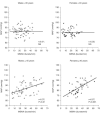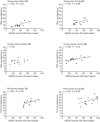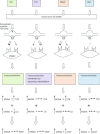Sex, ageing and resting blood pressure: gaining insights from the integrated balance of neural and haemodynamic factors
- PMID: 22351633
- PMCID: PMC3447151
- DOI: 10.1113/jphysiol.2011.224642
Sex, ageing and resting blood pressure: gaining insights from the integrated balance of neural and haemodynamic factors
Abstract
Young women tend to have lower blood pressure, and less risk of hypertension, compared to young men. As people age, both blood pressure and the risk of hypertension increase in both sexes; this occurs most strikingly in women after menopause. However, the mechanisms for these influences of sex and age remain incompletely understood. In this review we are specifically interested in the interaction between neural (sympathetic nerve activity; SNA) and haemodynamic factors (cardiac output, blood pressure and vascular resistance) and how these change with sex and age. While peripheral vascular SNA can vary 7- to 10-fold among normotensive young men and women, it is reproducible in a given individual. Surprisingly, higher levels of SNA are not associated with higher blood pressures in these groups. In young men, high SNA is associated with higher total peripheral vascular resistance (TPR), and appears to be balanced by lower cardiac output and less peripheral vascular responsiveness to adrenergic stimulation. Young women do not exhibit the SNA-TPR relationship. Recent evidence suggests that β-adrenergic vasodilatation offsets the vasoconstrictor effects of α-adrenergic vasoconstriction in young women, which may contribute to the generally lower blood pressures in this group. Sympathetic nerve activity increases with age, and in groups over 40, levels of SNA are more tightly linked to levels of blood pressure. The potentially protective β-adrenergic effect seen in young women appears to be lost after menopause and probably contributes to the increased blood pressure and increased risk of hypertension seen in older women.
Figures




Similar articles
-
Sympathetic regulation of blood pressure in normotension and hypertension: when sex matters.Exp Physiol. 2016 Feb;101(2):219-29. doi: 10.1113/EP085368. Exp Physiol. 2016. PMID: 26682826 Review.
-
Sex and ageing differences in resting arterial pressure regulation: the role of the β-adrenergic receptors.J Physiol. 2011 Nov 1;589(Pt 21):5285-97. doi: 10.1113/jphysiol.2011.212753. Epub 2011 Aug 22. J Physiol. 2011. PMID: 21859824 Free PMC article.
-
Sympathetic nerve activity and peripheral vasodilator capacity in young and older men.Am J Physiol Heart Circ Physiol. 2014 Mar;306(6):H904-9. doi: 10.1152/ajpheart.00181.2013. Epub 2014 Jan 10. Am J Physiol Heart Circ Physiol. 2014. PMID: 24414063
-
Quantifying sympathetic neuro-haemodynamic transduction at rest in humans: insights into sex, ageing and blood pressure control.J Physiol. 2016 Sep 1;594(17):4753-68. doi: 10.1113/JP272167. Epub 2016 Jul 3. J Physiol. 2016. PMID: 27068560 Free PMC article.
-
The impact of ageing and sex on sympathetic neurocirculatory regulation.Semin Cell Dev Biol. 2021 Aug;116:72-81. doi: 10.1016/j.semcdb.2021.01.001. Epub 2021 Jan 16. Semin Cell Dev Biol. 2021. PMID: 33468420 Free PMC article. Review.
Cited by
-
Differential influences of dietary sodium on blood pressure regulation based on race and sex.Auton Neurosci. 2021 Dec;236:102873. doi: 10.1016/j.autneu.2021.102873. Epub 2021 Sep 4. Auton Neurosci. 2021. PMID: 34509133 Free PMC article. Review.
-
Sex-related differences in heart failure patients: physiological mechanisms of cardiovascular ageing and evidence-based sex-specific medical therapies.Ther Adv Cardiovasc Dis. 2025 Jan-Dec;19:17539447241309673. doi: 10.1177/17539447241309673. Ther Adv Cardiovasc Dis. 2025. PMID: 39749975 Free PMC article. Review.
-
The relationship between muscle sympathetic nerve activity and systemic hemodynamics is altered in women with uterine fibroids.Physiol Rep. 2022 Sep;10(18):e15445. doi: 10.14814/phy2.15445. Physiol Rep. 2022. PMID: 36117415 Free PMC article.
-
Strain- and sex-specific differences in intestinal microhemodynamics and gut microbiota composition.Gastroenterol Rep (Oxf). 2024 Sep 16;12:goae087. doi: 10.1093/gastro/goae087. eCollection 2024. Gastroenterol Rep (Oxf). 2024. PMID: 39286773 Free PMC article.
-
[Hemodynamic changes in standing-up test of children and adolescents with postural tachycardia syndrome].Beijing Da Xue Xue Bao Yi Xue Ban. 2019 Jun 18;51(3):414-421. doi: 10.19723/j.issn.1671-167X.2019.03.007. Beijing Da Xue Xue Bao Yi Xue Ban. 2019. PMID: 31209411 Free PMC article. Chinese.
References
-
- Burt VL, Whelton P, Roccella EJ, Brown C, Cutler JA, Higgins M, Horan MJ, Labarthe D. Prevalence of hypertension in the US adult population. Results from the Third National Health and Nutrition Examination Survey, 1988–1991. Hypertension. 1995;25:305–313. - PubMed
-
- Cardillo C, Kilcoyne CM, Quyyumi AA, Cannon RO, 3rd, Panza JA. Decreased vasodilator response to isoproterenol during nitric oxide inhibition in humans. Hypertension. 1997;30:918–921. - PubMed
-
- Charkoudian N, Joyner MJ, Barnes SA, Johnson CP, Eisenach JH, Dietz NM, Wallin BG. Relationship between muscle sympathetic nerve activity and systemic hemodynamics during nitric oxide synthase inhibition in humans. Am J Physiol Heart Circ Physiol. 2006a;291:H1378–H1383. - PubMed
Publication types
MeSH terms
Substances
LinkOut - more resources
Full Text Sources
Medical
Research Materials

